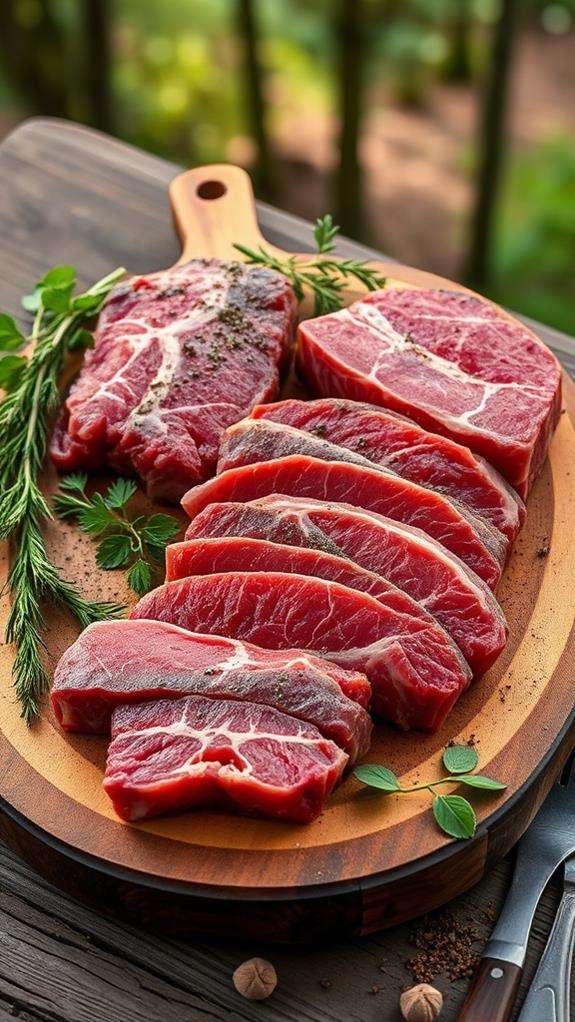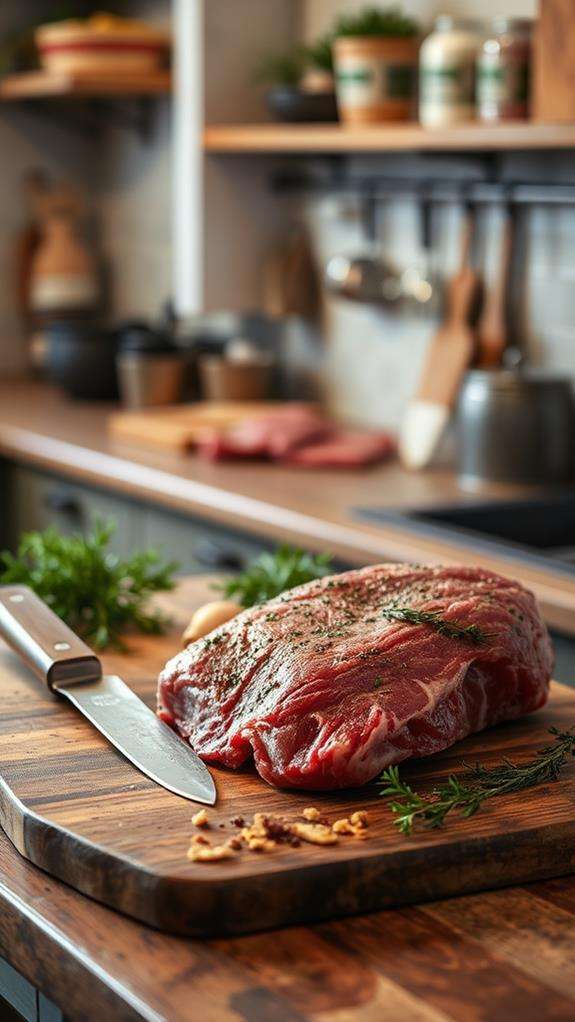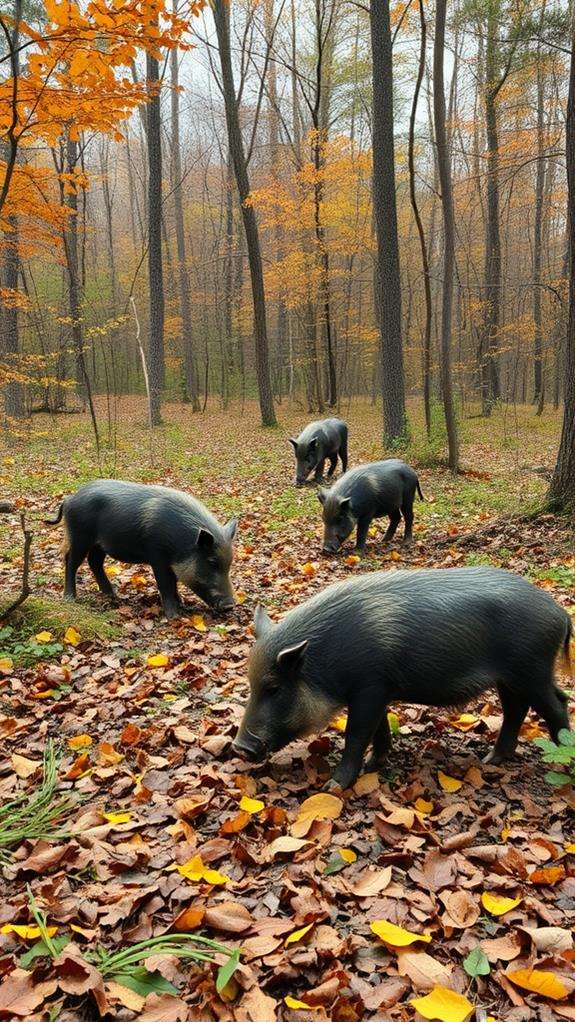Is It Safe to Eat Wild Hogs
Wild hog meat can be safe to eat, but it requires careful handling and preparation. You'll need to be aware of potential health risks, including parasites and diseases like trichinosis and brucellosis. To minimize these risks, wear gloves when field dressing, cool the carcass quickly, and maintain cleanliness during butchering. It's indispensable to cook the meat thoroughly to an internal temperature of at least 160°F (71°C) to kill any pathogens. When prepared properly, wild hog meat offers nutritional benefits, being lean and high in protein. However, you should also consider environmental impacts and local hunting regulations before pursuing this food source. Understanding the full picture will help you make an informed decision.
This post may contain affiliate links. If you make a purchase through these links, I may earn a commission at no additional cost to you. Additionally, portions of this post may be generated using artificial intelligence (AI) technology. While we strive for accuracy, please be aware that AI-generated content may not always be perfect and should be fact-checked when necessary.
The Spatula Scoops
- Wild hog meat can be safe to eat when properly handled and cooked to an internal temperature of 160°F (71°C).
- Parasites and diseases like trichinosis and brucellosis pose health risks, necessitating thorough cooking and careful handling.
- Environmental contaminants may accumulate in wild hog meat, requiring awareness of the animal's habitat and potential exposures.
- Proper field dressing, quick cooling, and hygienic processing are crucial to prevent bacterial contamination and ensure safety.
- Wild hog meat offers nutritional benefits, including high protein and low fat content, when consumed as part of a balanced diet.
Understanding Wild Hog Meat

Wild hog meat, also known as wild boar or feral pig, is a lean and flavorful alternative to domesticated pork. You'll find that it has a darker color and a more robust taste compared to farm-raised pork. This meat is typically lower in fat and higher in protein, making it a popular choice for health-conscious consumers. Similar to chicken, wild hog meat can vary in color and appearance, but proper cooking temperature is essential for safety regardless of visual cues.
When you're considering wild hog meat, it's important to understand its characteristics. The meat's texture can be tougher due to the animal's active lifestyle, which means you might need to adjust your cooking methods. Slow-cooking techniques, like braising or stewing, can help tenderize the meat. You'll also notice that wild hog meat has a distinct, gamey flavor that some people find appealing.
It's critical to source your wild hog meat from reputable hunters or suppliers who follow proper field dressing and handling procedures. This guarantees the meat's safety and quality. When preparing wild hog meat, always cook it thoroughly to an internal temperature of 160°F (71°C) to eliminate any potential parasites or bacteria. By understanding these key aspects of wild hog meat, you can make informed decisions about incorporating it into your diet.
Potential Health Risks
While wild hog meat can be a tasty and nutritious option, you should be aware of potential health risks associated with consuming it. Proper handling techniques, similar to those used for wild rabbits, are indispensable when preparing wild hog meat to prevent disease transmission. Parasites and diseases carried by wild hogs, such as trichinosis and brucellosis, pose significant concerns for hunters and consumers. Additionally, environmental contaminants that wild hogs may encounter in their habitats can accumulate in their tissues, potentially exposing you to harmful substances when you eat the meat.
Parasites and Diseases
How safe is wild hog meat when it comes to parasites and diseases? You'll need to be cautious, as wild hogs can carry various pathogens that pose risks to human health. These animals often harbor parasites like trichinella and toxoplasma, which can infect humans if the meat isn't properly cooked. Additionally, wild hogs may transmit diseases such as brucellosis and pseudorabies.
To better understand the risks, consider this table of common parasites and diseases found in wild hogs:
| Parasite/Disease | Transmission | Symptoms | Prevention |
|---|---|---|---|
| Trichinella | Eating undercooked meat | Nausea, diarrhea, muscle pain | Cook meat thoroughly |
| Toxoplasma | Handling raw meat or eating undercooked meat | Flu-like symptoms | Proper hygiene, thorough cooking |
| Brucellosis | Contact with infected animals or consuming raw milk | Fever, joint pain, fatigue | Avoid raw dairy, wear protective gear |
| Pseudorabies | Handling infected animals | Neurological symptoms in animals, rarely affects humans | Avoid contact with infected animals |
| Swine influenza | Close contact with infected animals | Respiratory symptoms | Limit exposure, practice good hygiene |
To minimize these risks, always cook wild hog meat to an internal temperature of 160°F (71°C). This will kill most parasites and bacteria. Additionally, wear gloves when handling raw meat and practice proper food safety techniques.
Contamination From Environment
The environment in which wild hogs live can introduce additional health risks to their meat. These animals often inhabit areas exposed to various pollutants and contaminants, which they may absorb or ingest. You'll need to evaluate potential exposure to:
- Heavy metals like lead or mercury from industrial runoff
- Pesticides and herbicides from agricultural areas
- Chemical waste from illegal dumping sites
Wild hogs are known for their scavenging behavior, which increases their risk of consuming contaminated materials. They'll eat almost anything they come across, including garbage and carrion. This indiscriminate feeding can lead to the accumulation of harmful substances in their tissues.
Additionally, hogs living near former industrial sites or military training grounds may be exposed to toxic chemicals or unexploded ordnance. These hazards can leach into the soil and water, contaminating the animals' food and drinking sources.
To mitigate these risks, it's essential to know the area where the hog was harvested. You should avoid consuming wild hogs from regions with known environmental contamination. If you're unsure about the hog's origin, consider having the meat tested for pollutants before consumption.
Proper Handling and Preparation

When handling and preparing wild hog meat, following proper safety protocols is essential. You'll need to wear gloves while field dressing and processing the animal to avoid direct contact with bodily fluids. It's of the utmost importance to cool the carcass quickly, ideally within two hours of harvest, to prevent bacterial growth. Similar to cleaning a bowling ball, maintaining cleanliness during the process is of paramount importance for safety and quality. Working in a well-ventilated area with a flat surface can help prevent contamination and make the task easier.
When butchering, use clean, sharp knives and sanitize all surfaces and equipment before and after use. You should trim away any visible fat, as it may contain higher concentrations of contaminants. Always cook wild hog meat thoroughly to an internal temperature of at least 160°F (71°C) to kill potential pathogens.
It's advisable to freeze the meat if you're not planning to consume it within a few days. Proper packaging, such as vacuum sealing, can help prevent freezer burn and extend shelf life. When thawing, do so in the refrigerator, never at room temperature.
Nutritional Benefits
When considering wild hog meat, you'll find it's an excellent source of protein and iron. You can expect a leaner meat compared to domesticated pork, which makes it a healthier option for those watching their fat intake. While the exact nutritional content may vary depending on the hog's diet and habitat, wild boar meat generally offers a rich array of essential nutrients that can contribute to a balanced diet.
Protein and Iron Content
Nutritional benefits stack up when it comes to wild hog meat. You'll find that it's an excellent source of protein and iron, two essential nutrients for your body's overall health. Wild hog meat typically contains more protein per serving than domesticated pork, making it an attractive option for those looking to increase their protein intake.
The iron content in wild hog meat is particularly conspicuous. It's rich in heme iron, which is more easily absorbed by your body compared to non-heme iron found in plant-based sources. This high iron content can help prevent anemia and support your body's oxygen-carrying capacity.
To visualize the nutritional profile of wild hog meat, consider these key points:
- Lean protein: 100 grams of wild hog meat provides approximately 25-30 grams of protein
- Iron powerhouse: Contains up to 3.5 mg of iron per 100 grams
- Low in fat: Typically contains less than 5% fat, making it a leaner option than domesticated pork
When incorporating wild hog meat into your diet, you're not only enjoying a flavorful protein source but also benefiting from its impressive nutritional composition. It's a nutrient-dense option that can contribute markedly to your daily protein and iron requirements.
Lean Meat Source
Building on the protein and iron content, wild hog meat stands out as an exceptionally lean source of animal protein. You'll find that it contains substantially less fat than domesticated pork, making it an attractive option for those watching their calorie intake. This leanness is due to the wild hog's active lifestyle and varied diet in natural habitats.
When you compare wild hog meat to other protein sources, you'll notice its impressive nutritional profile. It's rich in essential amino acids, which are essential for muscle growth and repair. The meat also provides a good balance of omega-3 and omega-6 fatty acids, supporting heart health and reducing inflammation.
For those concerned about their cholesterol levels, wild hog meat offers a healthier alternative to many traditional red meats. Its low saturated fat content can help you maintain healthy cholesterol levels while still enjoying flavorful meat in your diet. Additionally, the meat's leanness makes it an excellent choice for various cooking methods, from grilling to slow-cooking, allowing you to create nutritious and delicious meals while keeping fat content in check.
Environmental Impact Considerations

Considering the environmental impact of consuming wild hogs is essential when deciding whether to eat them. Wild hogs, also known as feral pigs, can cause significant damage to ecosystems. By consuming these animals, you're potentially helping to control their population and mitigate their negative effects on the environment.
When evaluating the environmental impact, consider these factors:
- Soil disturbance: Wild hogs root in the ground, disrupting native plant communities and soil structure.
- Water pollution: Their wallowing behavior can contaminate water sources and increase erosion.
- Competition with native species: Feral pigs often outcompete native wildlife for food and habitat.
However, it is crucial to recognize that hunting wild hogs isn't always a sustainable solution. Overhunting can lead to increased reproduction rates, potentially exacerbating the problem. Additionally, the carbon footprint associated with hunting and processing wild hog meat should be considered.
Before deciding to consume wild hog meat, research local regulations and conservation efforts. Consult with wildlife management professionals to understand the impact of hunting in your area. By making informed choices, you can help balance ecosystem health while potentially enjoying a lean protein source.
Regulations and Hunting Guidelines
Understanding regulations and hunting guidelines is crucial if you're considering hunting wild hogs. Each state has its own rules, so you'll need to research the specific requirements for your area. Generally, you'll need a hunting license and may have to follow restrictions on hunting seasons, bag limits, and approved methods.
| Regulation Type | Common Requirements | Variations |
|---|---|---|
| Licensing | Valid hunting license | Special hog permits |
| Seasons | Year-round in some areas | Restricted seasons |
| Methods | Firearms, archery, trapping | Night hunting allowed |
You'll also need to be aware of property laws. Many states allow landowners to hunt hogs on their property without a license, but you'll need permission to hunt on private land that isn't yours. Public lands often have their own set of rules, which may be more restrictive than those for private property.
Before you hunt, familiarize yourself with hog identification to avoid mistaking other wildlife for your target. Some states require you to report your kill or submit samples for disease testing. Always prioritize safety and ethical hunting practices, regardless of local regulations.
Frequently Asked Questions
Can Pregnant Women Safely Consume Wild Hog Meat?
If you're pregnant, it's best to avoid consuming wild hog meat. While it can be safe when properly cooked, wild hogs may carry diseases that pose risks to you and your unborn baby. Trichinosis, a parasitic infection, is a particular concern. Additionally, wild hogs can accumulate environmental contaminants. To err on the side of caution, it's recommended that pregnant women stick to commercially sourced meats that undergo strict safety regulations and inspections. Always consult your healthcare provider for personalized advice.
How Does Wild Hog Meat Taste Compared to Domestic Pork?
You'll find that wild hog meat, unlike your trusty telegraph, offers a distinct flavor compared to domestic pork. It's typically leaner and darker, with a more intense, gamey taste. You'll notice it's often tougher due to the hogs' active lifestyle. The flavor can vary based on the animal's diet and age. Some describe it as nutty or sweet, while others find it earthier. You might need to adjust your cooking methods to accommodate its unique characteristics.
Are There Age Restrictions for Eating Wild Hog Meat?
There aren't specific age restrictions for eating wild hog meat, but you should consider a few factors. Young children, pregnant women, and those with weakened immune systems might be more susceptible to potential foodborne illnesses. It's essential to properly cook wild hog meat to an internal temperature of 160°F (71°C) to eliminate parasites and bacteria. Additionally, be aware of local hunting regulations and food safety guidelines when consuming wild game. Always consult with a healthcare professional if you have concerns.
Can Wild Hog Meat Be Used in Cured Products Like Bacon?
Did you know that 70% of wild hog meat can be used for cured products? You can certainly use wild hog meat for bacon and other cured items. It's important to properly process and cure the meat to guarantee food safety. You'll need to follow specific curing methods, using salt, nitrates, and sometimes smoke. The result can be a flavorful and unique bacon product. However, always make certain the meat is thoroughly cooked before consumption to eliminate any potential parasites.
Is It Safe to Feed Wild Hog Meat to Pets?
You shouldn't feed wild hog meat to your pets without proper precautions. While it can be nutritious, it's vital to cook the meat thoroughly to eliminate parasites and bacteria. Trichinella spiralis, a common parasite in wild hogs, can infect dogs and cats. Additionally, wild hog meat may contain other pathogens harmful to pets. If you're considering feeding wild hog meat to your pets, consult your veterinarian first and guarantee the meat is fully cooked to an internal temperature of 165°F (74°C).
Conclusion
You've now explored the wild world of hog consumption, from the tiniest microbe to the mightiest boar. Remember, with proper handling and cooking, wild hog can be a safe, delicious addition to your diet. However, it's not without risks. Always follow local regulations, hunt responsibly, and prepare your meat carefully. While you won't turn into a superhero by eating wild hog, you'll certainly gain a unique culinary experience and potentially contribute to ecological balance. Happy hunting and bon appétit!





